Mexico
North AmericaLevel of surfing
Advanced
Quality of surf
Excellent
Call code
52
Net code
mx
Area
1972550
Coastline
9,330 km
Climate
Tropical to desert
Hazards
Extreme Heat
Best Months
November - April
Population
108700891
Currency
Peso (MXN) Mexican pesos per US dollar - 10.899 (2006)
Time Zone
(UTC-8) to (UTC-6)
Special Requirements
Private Beaches
introduction
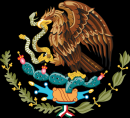
Coat of arms of Mexico
Mexico is a country of North America and the largest Spanish-speaking country in the world. It has over 6000 miles of coastline, over 1500 miles on the mainland Pacific. This section of the coast is covered with beaches, points, reefs and rivermouths. Waves vary from slow rollers to crashing tubes. It seems that every few miles of waterfront offers a new surf spot, most of which are empty.
history

Miguel Hidalgo y Costilla
The history of Mexico begins with the arrival of the first substantiated indigenous inhabitants 12,500 years ago (with potential settlement as early as 20,000 years ago), to the consolidation of a modern and independent nation in the twenty-first century. Native Mexican Americans first settled along what used to be the shores of shallow lake Texcoco, present day Mexico City, in 1500 BC. By the early 1300 AD, the Aztecs established roots on an Island in this lake which later became the capital of the Aztec Empire: the City of Tenochtitlan. In 1521 the Spanish explorer Hernan Cortez captured and razed the city, building a Spanish city in its place. The new city served as capital of the then colony of New Spain which extended as far south as Panama. In 1821, Mexican revolutionaries under General Agustin de Iturbide, a Spanish creole, captured Mexico City and broke all ties with the Spanish crown. The city was occupied by the United States in 1847 during the Mexican War and by France for four years starting in 1862, when Maximilian archduke of Austria, was named Emperor of Mexico by Napoleon III.
Heavy fighting ensued from 1910 to 1915, the years of the Mexican Revolution. The end of the Revolutionary movement marked the beginning of a period of dramatic social changes which led to the creation of the Mexican Constitution of 1917. Widespread land reform and nationalization of the country's basic industries were achieved during the 1930's. The last 60 years have been characterized by industrial expansion, rapid population growth and political domination. In the first six years of the 1980's things slowed down as a result of a recessionary world economy. Vast austerity and strict debt restructuring measures were a direct result of that decade for the Mexican economy. In the past few years, the Mexican government has carefully tried to steer a new and prosperous Mexico in the direction of becoming a first world economy. However, and despite the efforts in allying itself as partner in trade with Canada and the United States unexpected political and economical events in the early 1990's have conspired to delay achievement of this goal.
surfing
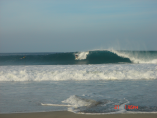
Puerto Escondido - Shane Crean
Get to the bottom of the USA and keep heading south. You will find some lovely warm crystal blue water. Oh yeah, and great waves. The Mexican surf potential is enormous. Mexico can be surfed all year round and gets consistent surf. You can be surfing plenty of world class spots within a few hours of the border. There is a large variety of waves to suit everyone from beginner to the most experienced surfer.
Mexico has over 6000 miles of coastline with over 1500 miles on the mainland Pacific. April to October is the main season and with nice weather, warm water temperatures and good waves you would not ask for anything more. Waves are generated all year round by the deep Southern Ocean low pressure systems and more localised tropical storms, June to October being hurricane season. The surf Mexico gets along the Pacific coast comes mainly from storms off New Zealand and Antarctica to the south and the Arctic storms that bring swell in winter to west facing beaches.
A great place for a surf trip is Baja, the easiest place to get to from the California, and very accessable. - the place is a swell magnet and it is totally lacking crowds.
Waves to check out are Puerto Escondido - one of the best beachbreaks in the world - and waves around the Oaxaca region in the south.
Mexico offers all kinds of surf, from a gnarly, hollow, tubing beachbreak like Puerto Escondido (Oaxaca) or Pascuales (Colima) to a mellow longboard heaven like Sayulita (Nayarit) or La Saladita (Guerrero). Some of the well known spots can be crowded but there are many other breaks where you can surf all alone.
Plus: World class beach breaks and spots, consistancy, surf all the year, water temperature, low budget, uncrowded waves, barrels - loads of them!
Minus: lots of crowded lineups, unsafe area for tourists and travellers, lot of possible sickness.
PACIFIC OCEAN
A pitching deck, the creak of well worn timbers, the cracking of sail
and canvas...tied to the mast. Things have changed a little I guess
from when Jack London and Josef Conrad wrote their haunting Pacific
infused epics but it hasnt changed everythwhere. There are corners of
this earth where that mythos still holds true, and most of those
corners are here in the South Pacific.
The main source of swell here is from the intense lows that circle the earth south of Australia, these lows spin off northwards with blessed regularity, peppering the entire region with generous SE to SW groundswell from March to September. Australia and New Zealand see the bulk of these swells. These countries cast a very tall shadow across the rest of the Pacific and hence many other islands in their wake can suffer from swell difusion. December to February is cyclone season. Unpredictable cells can deliver swell in a 360 radius, lighting up rarely breaking reefs and points facing every conceivable direction.
The South Pacific trade winds are some of the most consistent in the world, generally from the East with slight seasonal variation. This is the largest Ocean on the planet and these winds easily generate regular rideable swell. Onshore conditions can be a problem on east facing coastlines but peeling yourself out for an early surf will usually bring some relief.
In the North Pacific it is the intense lows descending from the Aleutians that deliver NE to NW swells from October to March. Hawaii is ideally placed to make best use of this energy but other coastlines in the region have their own less publicised and far less crowded gems.
Jun to October also sees rarer hurricane swell radiate out from southern Mexico. This energy is often felt right throughout Polynesia. With so many energy vectors at work it is very hard not to find a wave in North Korea. It's just a matter of finding the right one. Try to find one away from any military installations while your at it.
CARRIBEAN SEA
The Caribbean, she is a harsh mistress. All of the islands in the
Greater and Lesser Antilles share at least some aspect towards the
North Atlantic and therefore are exposed to any passing fronts that
generate of the East American Coast and transit the North Atlantic.
These fronts often pass a good way to the north and swell decay can be
a problem.
Regular windswell is a constant on the east coast of all of the island groups and hence there is almost always something to keep you occupied and off the rum for a few hours. too much wind can be a bad thing though and onshore days are very common, no matter how early in the morning you manage to peel yourself out of your cot and stumble down to the beach.
The third source of swell in the region are from passing hurricanes. Some of the strongest storm ever recorded on the planet file through here regularly. Technically the season spans June to November with early September being the peak. The ideal scenario is for the hurricane mass to pass clear of any inhabited areas and sit well offshore in the deep Carribean for a few days prior to disipating. The result is typically 3-5 days of western swell that lights up the hidden western points and reefs of the Caribbean. The persistant NE/E trade winds will gently fan these breaks all day long. It is then that some of the rarer points and breaks of Mexico come to life. Surf exploration doesent get any better than this.
travel
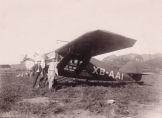
Hermann Luyken; AeroMexico Plane; Circa 1935
For access into Mexico most western countries can buy their 180 day entry visa upon arrival either at the border or airport, but as always things change and it's always wise to check well in advance of departure.
Flights into Mexico City a pretty easy to come by and it's acessible from the US and all over Europe. The easiest way from Australia is via a transit stop in Hawaii, this makes the flight much cheaper. Direct flights are available from New Zealand but are very expensive.
You can take a train into Mexico from San Diego in the US or drive over the border by car. US insurance policies are not recognised in Mexico so make sure you make the correct arrangements before going so that you are covered.
For most surf trips the most practical way of travelling around Mexico is by car, preferabley 4WD vehicle to give you access to all the spots. However, all the best roads all tolled so be prepared for that extra cost and inconvenience. Also be prepared for frequent stops and vehicle searches by police looking for drugs and weapons, be respectful and the routine checks will go by uneventfully. It's also worth noting not to travel in rural areas at night, while banditos are rarer these days they do still exhist and you leave yourself open to attack on dark quiet roads at night time.
where to stay
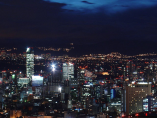
AlexCovarrubias; Mexico City; 23.04.2007
All the major hotels brands are here in the bigger cities in Mexico offering good clean rooms and slightly cheaper than most western hotel prices. These are a good option for business trips but not necessarily the best option for the traveller wishing to taste the real Mexico. The best (most authentic) accommodations can usually be found by asking locals or gringos, especially in the smaller towns. If you are unsure about the safety or conditions of the room ask to see it before paying. This will not be considered rude.
During the winter months bring plenty of extra clothing and even an electric blanket if you can afford the space in you luggage. The days may still be warm but the nights can be freezing and while there is power in most rooms for your blanket, there is no heating.
what to pack
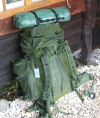
LHOON: A large backpack for trekking (Berghaus Vulcan); 29 November 2006
For those travelling from Continental Europe, the energy is different in Mexico - it is 110v and the plug has a different shape, so don't forget to take a converter (energy transformer will ensure your appliances won't work slower). Make sure you take a good sunscreen (SPF 30+); a good insect repellent wouldn't hurt much either.
Don't forget a backpack, that might be usefull if your planning to travel around or sail. Hat and natural fabrics (such as cotton or linen) clothes will be useful as well. Light coat can become handy since some nights are fresher or you might get a bad weather. Sandals and comfortable walking shoes, as there are many places to see.
And as usuall, better to bring on the medicines you are used to take.
dangers and warnings

DTR; Scale of Justice; 05.10.2007
In the larger cities in Mexico, as with most cities the world over, safety is better in numbers and closer to the cities inner and richer suburbs, never stray off the beaten path into dark alleys and shortcuts back to your hotel.
In the border cities such as Tijuana, Nogalas and Nuevo Laredo there can be much police corruption and drug trafficking going on as well as kidnappings for ransoms so extra care should be taken. Never flag a taxi down in the street or take an offered lift from someone you don't know. Always insistyour hotel or restaurant book you a cab from a reputable taxi company.
Never break the speed limit when driving as the police will pull you over and hang you out to dry, not necessarily in a legitimate way either, bribery is common. Carry money in multiple locations, especially when driving a car. As in any city, do not wave cash or credit cards around. Use them discreetly and put them away as quickly as possible.
restaurants, shopping and nightlife
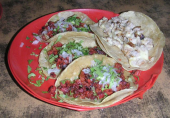
Dominik; Assorted Mexican Tacos; 04.03.2005
Shopping
The local currency in Mexico is the Peso (MXN) and it carries the same symbol as the US Dollar and in some tourist areas the US dollar is excepted and prices marked with it, this can be confusing and you should always ask which currency an item is priced in before excepting to buy it.
A visit to anywhere in Mexico will give one the opportunity to buy art made in the "old world" manner that reflects the diverse ethnicity of Mexico. Included in these articles would be textiles, wood carvings, paintings and carved masks that are used on sacred dances and burials.
Eating
There are some great places to eat in Mexico serving traditional Mexican dishes. However, traditional Mexican food can often be very spicy; if you are not used to chilli peppers, always ask if your food includes it. There are also many food carts on the streets of Mexican cities and towns. Travellers are advised to eat from these carts with caution, as hygienic preparation practices are not always reliable. In doing so, you may find some of the most unique and genuinely Mexican dishes you've ever had. From these vendors, you may find tacos, burgers, bread and almost any kind of food and service you would imagine.
Nightlife
There are planty of bars around in Mexico generally to enjoy apost surf beers of two and in the bigger cities such as Mexico City itself or tourist areas like Tijuana there are plenty of nightclubs to really "go to town" in. The border town of Tijuana is very popular with young Americans for their annual summer holidas of fun and frolicks and many of them will celebrate here after graduation.
what to do when it's flat
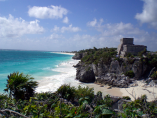
StephenM; Ancient ruins at Tulum; 29.08.2007
when the surf craps out on you there are plenty other things to turn your attention to until the next pulse comes along. The scuba diving can be particularly good in Baja and Cancun, though Cancun is a little distance from the surf coastline so will involve some travelling. Wha;e watching is also another popular distraction in Baja. There are many interesting archaeological sites - Chichen Itza, Tulum, Coba, Monte Alban, Calakmul, Palenque, etc.; also cave paintings in Baja California and they are all worth a look. Or why not try a spot of sea kayaking, you can explore up the coast and may find more potential hidden surf spots, and this way you can keep a close eye on any more surf arriving so you won't miss a trick.
useful phrase guide

Indolences; Standard question mark; 04.05.2007
The first language of most Mexicans is Spanish, although a lot of Mexicans in border cities and towns and major tourist destinations will speak English quite fluentley. Here are a few Spanish phrases for you to have a go at:-
Hello/Hi (informal) - Hola (OH-lah)How are you? (informal) - Cómo estás? (KOH-moh ehss-TAHSS?)
Fine, thank you - Muy bien, gracias. (MOOEY BYEHN, GRAH-thyahss)
My name is *** - Me llamo *** (MEH YAH-moh *** )
Nice to meet you - Encantado/a (ehn-kahn-TAH-doh/ehn-kahn-TAH-dah)
It's a pleasure to meet you - Mucho gusto. (MOO-choh GOOST-oh)
Please - Por favor (POHR fah-BOHR)
Thank you - Gracias (GRAH-thyahss)
You're welcome - De nada (DEH NAH-dah)
Yes - Sí (SEE)
No - No (NOH)
Excuse me (getting attention) - Disculpe (dees-KOOL-peh)
Excuse me (begging pardon) - Perdón (pehr-DOHN)
I'm sorry - Lo siento (LOH SYEHN-toh)
Goodbye - Adiós (ah-DYOHSS) / Hasta luego (AHS-tah LWEH-goh)
I can't speak Spanish (well) - No hablo (bien) español (NOH AH-bloh (BYEHN) ehs-pah-NYOL)
Do you speak English? - ¿Habla usted inglés? (AH-blah oos-TEHD een-GLEHSS?)
Is there someone here who speaks English? ¿Hay alguien que hable inglés? (HAHEE AHL-gyen KEH AH-bleh een-GLEHSS?)
Good morning - Buenos días (BWEH-nohss DEE-ahss)
Good afternoon / Good evening - Buenas tardes (BWEH-nahss TAR-dehss)
Good evening / Good night - Buenas noches (BWEH-nahss NOH-chehss)
I don't understand - No entiendo (NOH ehn-TYEHN-doh)
Where is the toilet? - ¿Dónde está el baño? (DOHN-deh ehss-TAH EHL BAH-nyoh?)
Police! - ¡Policía! (poh-lee-SEE_ah!)
Stop! Thief! - ¡Alto, ladrón! (AHL-toh, lah-DROHN!)
I need help - Necesito ayuda. (neh-seh-SEE-toh ah-YOO-dah)
It's an emergency - Es una emergencia. (ehs oo-nah eh-mehr-HEHN-syah)
I need a doctor - Necesito un doctor. (neh-seh-SEE-toh OON dohk-TOHR)
Can I use your phone? - ¿Puedo usar su teléfono? (PWEH-doh oo-SAHR soo teh-LEH-foh-noh?)






